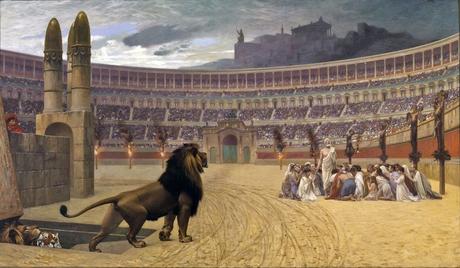For over 400 years the Colosseum was a symbol of the power of Ancient Rome as well as a showcase of the extraordinary engineering capabilities of the empire. It stood proudly as the pinnacle of social life in Roman and at its height could fit between 50,000 to 80,000 spectators inside the grand amphitheater. Commissioned by Emperor Vespasian of the Flavian dynasty in the year 70 AD, the Colosseum took just over 10 years to complete and was built mainly by Jewish slaves. Whilst they were unpaid for their strenuous work, Roman engineers, architects and sculptors were brought in for the finer details. The Colosseum played a main part of the daily life of Roman citizens, who often revelled in the blood sports that occurred there.
Gladiators
To the residents of Rome, gladiators were held in high regard for their willingness to die for the fame and glory. The role of the Gladiator was to entertain the crowd, purposefully lengthening the time of their battles and the action to capture the attention of the audience. The Gladiators were almost always slaves, criminals or prisoners of war however they were then sent to a specialist training school to hone their fighting style and be trained in the art of wielding weapons that suited their physique. The fighters were known for the hunting of wild animals in the arena, re-enacting military victories and fighting to the death purely for the pleasure of their Emperor and the people.
Mock Water Battles
Perhaps one of the lesser known uses for the Colosseum, was where gladiators engaged in mock water battles at the Colosseum to re-enact famed battles. The Colosseum was water tight, on an account of it being built on the site of a man-made lake, meaning that they could easily flood the stadium floor. Scholars have found that this was only done a handful of times as it was known to damage the foundation of the Colosseum. The arena floor could be filled with enough water to allow ships to sail and featured gory and dramatic battles between gladiators who fought on opposing ships. As it was an expensive and illustrious undertaking, it was accounted that these battles only happen about a dozen times before they moved the event to natural bodies of water.
Animal Hunts
The slaying of animals by gladiators was a spectator sport in daily Roman life. The inauguration of the Colosseum saw over 9,000 animals slaughtered by gladiators. Overall, it is estimated that over a million exotic animals perished in the bloody battles. Animals from Egypt such as leopards, camels, lions and snakes were amongst the many that were sometimes unleashes on prisoners who had nothing to defend themselves with. This became such a lucrative trade that it led to the extinction of certain types of species in parts of the world. The stage was set on the ground of Colosseum complete with trees and bushes to give the impression of the audience watching in on a natural environment. The animal shows were conducted in the morning as a prelude to the gladiator fights that were held later in the day. Wealthy nobles and commoners alike were allowed to witness the spectacle, with some Emperors even participating in the carnage when it was safe for them to do so.
Advertisements

